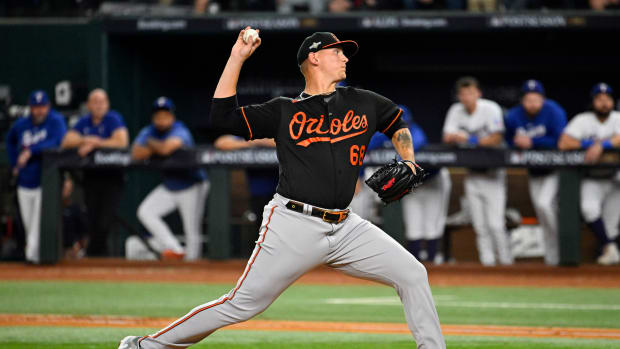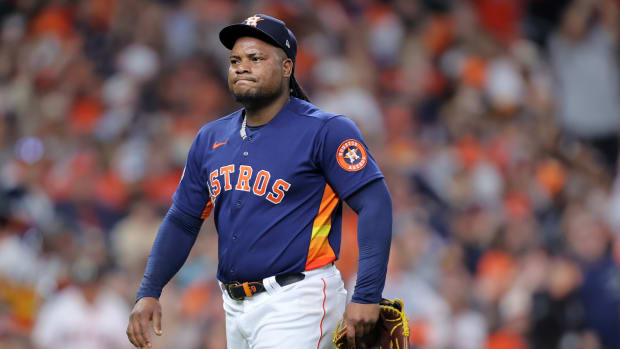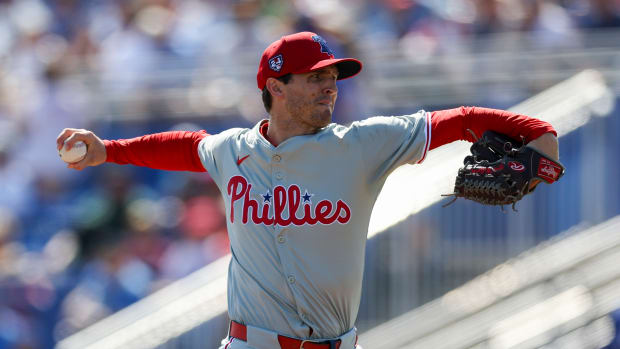Does No. 1 farm system ranking spell future success for MLB teams?
Whatever your opinion of the Minnesota Twins' offseason might be (our Jay Jaffe offers his today in our Winter Report Card series), their future seems bright. Minnesota boasts one of the richest farm systems in baseball, and last March, Baseball Prospectus rated the Twins as the top organization in all of baseball, edging out the Cubs, this year's likely pick, and the Pirates, Baseball America's choice for 2014. That got us wondering about the previous teams to earn Baseball Prospectus' top ranking, and whether having the best farm system has typically led to major league success. Here's a look back at the No. 1 organizations since Baseball Prospectus started ranking farm systems under the direction of Kevin Goldstein in 2007.
2014
Top Organization: Minnesota Twins
Top Prospects: CF Byron Buxton, 3B Miguel Sano, RHP Alex Meyer
A's radical roster re-do just part of larger trend around baseball
Major League Impact: Shortstop-turned-centerfielder Danny Santana and first baseman-turned-designated hitter Kennys Vargas made strong debuts in 2014, nailing down spots in the 2015 lineup, and sophomores Oswaldo Arcia and Kyle Gibson established themselves in the outfield and rotation, respectively. Sano, however, had his major league debut delayed by Tommy John surgery, which wiped out his entire season, and Buxton, widely considered the best prospect in all of baseball, was limited to 134 plate appearances by a pair of left wrist sprains and an ugly outfield collision in August that resulted in a season-ending concussion. Those injuries set both players back a year in terms of development. Nonetheless, both Sano and Meyer, the latter of whom had an uneventful Triple A debut last season, could make their major league debuts this year, and Buxton, if fully recovered from his concussion, could move quickly.
2013
Top Organization: St. Louis Cardinals
Top Prospects: OF Oscar Taveras, RHP Shelby Miller, RHP Carlos Martinez, RHP Trevor Rosenthal, RHP Michael Wacha, 2B Kolten Wong, RHP Tyrell Jenkins, 1B Matt Adams
Major League Impact: Looking at that list, it's no wonder St. Louis was ranked the top organization. Miller finished third in the 2013 Rookie of the Year voting and was a key part of the rotation for that year's National League Central champions. Wacha (the team's No. 2 starter), Rosenthal (closer) and Martinez (setup man) all starred in that year's postseason as St. Louis won the NL pennant and pushed the Red Sox to six games in the World Series. Adams, who started at first base in the 2013 postseason, was the team's regular first baseman in 2014, and Wong emerged as the starter at second base. Those two combined to hit six home runs in the 2014 postseason.
Winter Report Card: Texas Rangers
Not included on that list is Matt Carpenter, who as a sophomore in 2013 finished fourth in the NL MVP voting, and righty reliever Seth Maness, who has been a key part of the Cardinals' bullpen over the last two seasons. Tragically, we'll never know how good Taveras could have been, as he was killed in a drunk driving accident in October at the age of 22. There's little doubt that the void his death left in the outfield prompted the Cardinals to trade Miller and Jenkins to the Braves for Jason Heyward.
2012
Top Organization: San Diego Padres
Top Prospects: OF Rymer Liriano, LHP Robbie Erlin, 3B Jedd Gyorko, 2B Cory Spangenberg
Major League Impact: The Padres earned the top spot two months after trading Anthony Rizzo to the Cubs in a four-player deal that netted Andrew Cashner. Earning their ranking more for quantity than quality — Goldstein's explanatory comment read, "They might lack that one marquee name, but no system in baseball can boast of having as many players at the upper levels who project as average or better big leaguers" — the Padres subsequently had that depth tested by a rash of Tommy John surgeries that impacted not only their pitching prospects, but also Liriano, costing him the entire 2013 season.
Even setting aside those derailed by Tommy John (a list that includes Casey Kelly, Joe Wieland, and Cory Luebke, the last twice), the 2012 Padres' system has thus far been a collective bust. There's still time, though, for the four players listed above, Kelly, or catcher Austin Hedges, now the team's top prospect, to make an impact at the major league level.
• CORCORAN: Winter Report Card: Rockies snooze through quiet off-season
2011
Top Organization: Kansas City Royals
Top Prospects: 3B, Mike Moustakas, LHP John Lamb, 1B Eric Hosmer, C Wil Myers, LHP Mike Montgomery
Major League Impact: It may not have been as direct as anticipated, but it's impossible to ignore the connection between this ranking and the Royals winning the AL pennant in 2014. Even if last year's Royals overachieved, they still posted their best record since 1994 and made the playoffs for the first time since 1985, and the building blocks of that team came from that top-ranked farm system and that winter's Zack Greinke trade, which brought in shortstop Alcides Escobar and centerfielder Lorenzo Cain.
Winter Report Card: Houston Astros
The Royals' system produced catcher Salvador Perez, Hosmer, Moustakas, closer Greg Holland (whose major league debut in 2010 consisted of just 15 games), ace reliever Kelvin Herrera (who made his major league debut in 2011), righty Yordano Ventura, lefties Danny Duffy and Tim Collins, speedster Jarrod Dyson (whose 2010 debut consisted of just 18 games), and infielder Christian Colon. The farm system also helped net staff ace James Shields and setup man Wade Davis, with Myers, Montgomery, and Jake Odorizzi (acquired in the Greinke trade) as the top three players sent to Tampa Bay in that swap.
2010
Top Organization: Tampa Bay Rays
Top Prospects: CF Desmond Jennings, RHP Jeremy Hellickson, RHP Wade Davis, RHP Alex Colome, LHP Matt Moore
Major League Impact: Davis joined the rotation in 2010 and finished fourth in the Rookie of the Year voting, excelling in relief in 2012 and helping to net Myers and company in the above-mentioned Shields trade. The real impact of this group wasn't felt until 2011, however. That's when Hellickson won the Rookie of the Year award, Jennings established himself in the outfield, and Moore caused a sensation at season's end, making a Game 1 playoff start and landing an eight-figure contract before making his second regular-season start. This group, which also included now-closer Jake McGee and lefty Alex Torres, who is now teammates with Myers in San Diego, undoubtedly helped the Rays extend their run of success. But they ultimately proved inferior to the prospects who pushed the Rays into contention in the first place, resulting in Tampa's recent tumble from those heights.
2009
Top Organization: Oakland Athletics
Top Prospects: RHP Michael Ynoa, RHP Trevor Cahill, LHP Brett Anderson, 1B Chris Carter
Major League Impact: The Athletics' recent run of success was actually a step removed from this group, but they provided some key trade fodder. Andrew Bailey wasn't considered one of Oakland's top 14 prospects by Baseball Prospectus in February 2009, but he won that year's AL Rookie of the Year as the team's closer, was an All-Star in 2009 and '10, then helped bring Josh Reddick to Oakland in a five-player trade. Cahill made the All-Star team in 2010, then went to the Diamondbacks in a five-player deal for Jarrod Parker and Ryan Cook. Gio Gonzalez, ranked seventh on the list, was an All-Star in 2011, then was flipped to the Nationals in a six-player deal for Derek Norris, Tommy Milone and pitching prospect A.J. Cole, who later returned to the Nats for John Jaso. Chris Carter was a big bat for the 2012 A's, who improved by 20 wins over the 2011 squad, but was flipped in a five-player deal for Jed Lowrie after that season.
Athletics in 'win now' mentality with acquisitions of Zobrist, Escobar
Ultimately, the most important player in the Oakland farm system in 2009 proved to be Josh Donaldson, who was acquired from the Cubs as a minor league catcher in June 2008 but, like Bailey, didn't make the list of the Athletics' top prospects the following February. Among those who did make the list, second baseman Jemile Weeks, ranked ninth, excelled as a rookie in 2011, but was a hindrance to Oakland's breakthrough the next year and a non-factor thereafter. Even the trade that sent him out of the organization, netting Orioles closer Jim Johnson, was a bust. Sean Doolittle was ranked tenth on the 2009 list but as a first baseman; he didn't move to the mound until 2012. Ynoa and Anderson, meanwhile, were undermined by injuries. Anderson, who fetched Drew Pomeranz last winter, couldn't stay healthy after a solid major league debut in 2009. Ynoa, whom Goldstein called "the best Latin American prospect of the decade" when the righthander was just 17, had Tommy John surgery in 2010 and was flipped to the White Sox in the Jeff Samardzija trade last month.
• JAFFE: As ace of free agency, what's Scherzer really worth?
2007, 2008
Top Organization: Tampa Bay Rays
Top Prospects: 3B Evan Longoria, LHP David Price, RF Delmon Young, SS Reid Brignac, RHP Jeff Niemann, LHP Jacob McGee, RHP Wade Davis, OF/1B Elijah Dukes, RHP Jeremy Hellickson, CF Desmond Jennings
Major League Impact: Given that the Cardinals were just two years removed from a championship when they were ranked as the top organization in baseball in 2013, the success stories on this list are that of the 2014 Royals and the 2008-13 Rays. Of those two, the Royals may have gotten a bit lucky, and it remains to be seen if they can sustain their success moving forward. The Rays, however, rank among the best examples of turning minor league promise into major league success. Armed with nearly a decade of elite draft picks, from Josh Hamilton in 1999 through Longoria in 2006 and Price in 2007, the Rays collected so much talent that not even the occasional disaster (Hamilton's drug abuse and three years out of baseball, the injuries and illness which derailed Rocco Baldelli's career, or a pure bust like Dewon Brazelton) could keep them from the inevitable big step forward.
What's He Really Worth: James Shields a stretch at $100 million
That step came in 2008, when the team improved by 31 games, going worst-to-first and winning the AL pennant. That team was led at the plate by Rookie of the Year Longoria, who would emerge as one of the game's best players. Young finished second in the Rookie of the Year voting in 2007, then was flipped to the Twins in a six-player trade that brought back righty Matt Garza and slick-fielding shortstop Jason Bartlett, who proved to be keys to the team's breakthrough in 2008. Garza later fetched Chris Archer, among others, in a trade after the 2010 season. Niemann proved a solid contributor to the big-league rotation in 2009, though his stay was brief. Several of the others listed above would carry over to the organization's top ranking in 2010. The gem of the Rays' system, however, proved to be Price, who would go on to become one of the elite pitchers in the game, winning the 2012 AL Cy Young award, finishing second in the 2010 voting, and making four All-Star teams.
The Rays won more games from 2008 to 2013 than any other team in baseball other than the Yankees. That run is over for Tampa Bay, but their success during those six seasons stands as a beacon to the Royals, Twins, Cubs, Pirates, Astros, and every other rebuilding or rebuilt team. Even without an expanded payroll, the promise of a great farm system can not only be realized, but also sustained at the major league level.



































